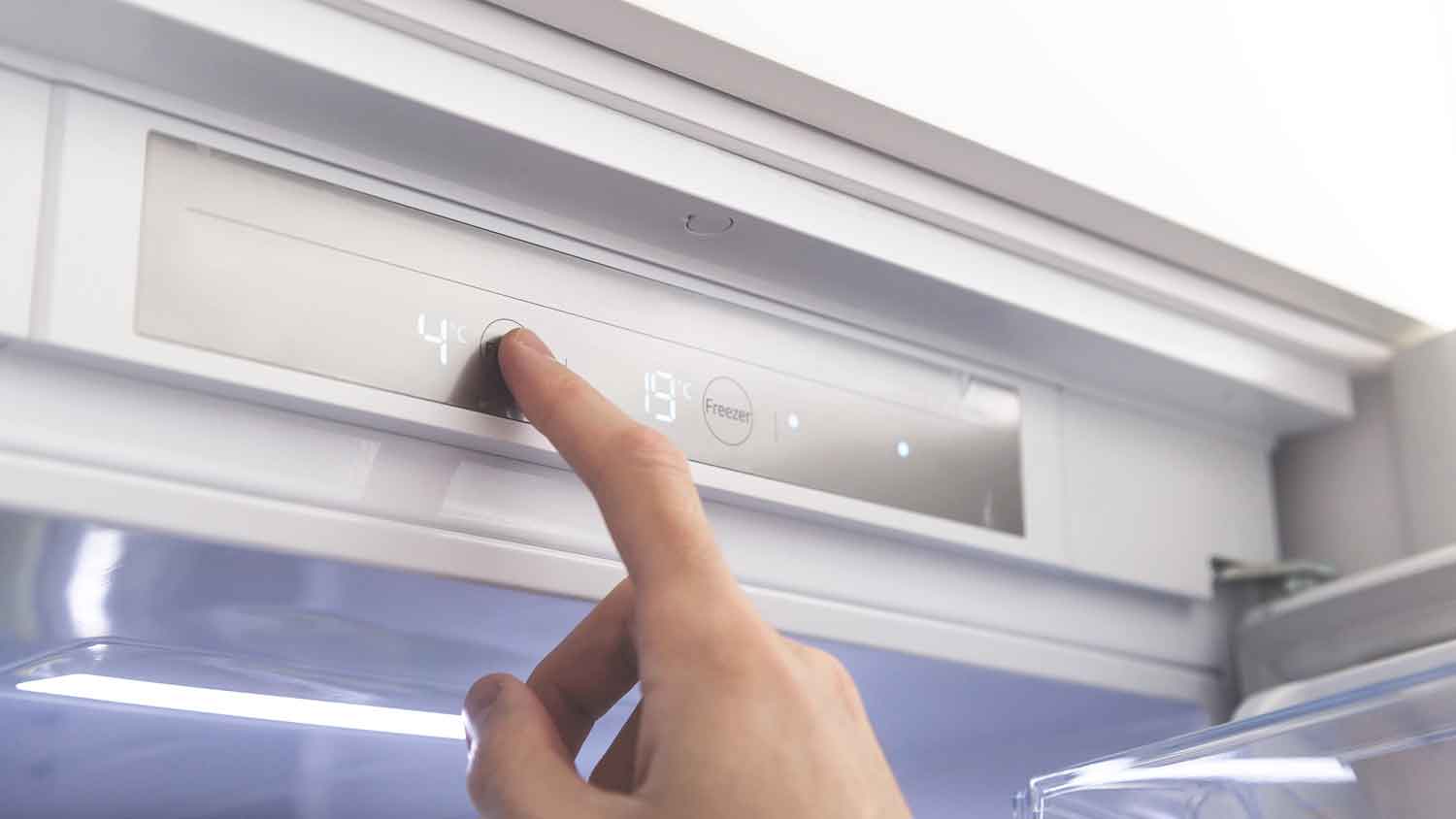
If your refrigerator has been damaged, refrigerator door dent repair cost will vary based on the imperfection's size, depth, and location. Use our guide to estimate how much you'll spend on refrigerator dent repair.
If your refrigerator isn’t keeping your food nice and cold, you may need to roll up your sleeves and fix it


Blocked air vents are a cause of malfunctions and are easy to fix.
Some repairs—like malfunctioning compressors—are best left to professionals.
Repairs can be pricey (up to $600), so try DIY repairs when possible.
Is your refrigerator failing to keep it cool? A malfunctioning refrigerator can be a major inconvenience, potentially leading to spoiled food and wasted groceries. This is why it’s important to act when there are signs of your refrigerator dying. There are several common reasons you can end up with a refrigerator not cooling properly.
Let’s delve into these common issues and outline the next steps you should take to address them.
Refrigerator repairs can be complicated and hazardous to one's health. If you don't have prior experience with this project, contact a local pro to ensure the job is completed safely.
Condenser coils are an essential component of your refrigerator's cooling system. Usually located at the back or underneath the unit, they play a vital role in releasing heat from the appliance. Over time, however, they can become covered in dust and debris, preventing efficient heat dissipation.
Signs: You might notice that the back of the refrigerator feels unusually warm to the touch. Additionally, the compressor might seem to be running constantly in an attempt to compensate for the reduced cooling efficiency.
Severity: This issue is moderate. While not an emergency, neglecting dirty condenser coils can strain the compressor, decrease overall energy efficiency, and lead to longer cooling cycles.
Next steps: To rectify this problem, consider vacuuming or gently brushing the coils to remove accumulated debris. If you're uncomfortable performing this task, call a local appliance technician who can handle the cleaning for you. You can find a refrigerator repair professional near you to help with this. The refrigerator repair cost for this issue ranges from $50 to $100.
The evaporator fan ensures an even distribution of cold air within the refrigerator and freezer compartments. This air circulation maintains consistent temperatures throughout the appliance. If the evaporator fan fails, your refrigerator's cooling capability will be compromised.
Signs: An audible hum from the fan might be present, but despite that, you'll notice a distinct lack of cold air. This could be accompanied by ice buildup on the evaporator coils.
Severity: This issue is highly severe. A malfunctioning evaporator fan can result in uneven cooling, leading to premature spoilage of food items.
Next steps: To restore proper functionality, the evaporator fan motor should be replaced. Given the technical nature of this task, it's advisable to enlist the assistance of a professional refrigerator technician. This repair costs between $100 and $200.

The thermostat controls the temperature inside your refrigerator. When it malfunctions, the appliance may struggle to cool your items to the desired level.
Signs: You might notice inconsistent refrigerator temperature levels, with items freezing in the refrigerator section or not staying as cold as they should be.
Severity: The severity of this issue is moderate. While not an immediate emergency, a malfunctioning thermostat can lead to food spoilage and unnecessary energy consumption due to extended cooling cycles.
Next steps: To address this problem, consider replacing the thermostat. To replace a refrigerator thermostat, start by disconnecting the power to the appliance. Next, remove the control panel cover, disconnect the old thermostat's wires, attach the wires to the new thermostat, secure it in place, and reassemble the control panel cover.
The compressor is often referred to as the heart of your refrigerator's cooling system. It's responsible for compressing the refrigerant gas, which facilitates the cooling process. If the compressor fails, your refrigerator won't cool at all.
Signs: You might hear clicking sounds emanating from the refrigerator, notice excessive heat emitting from the back, and realize that the cooling system is unresponsive.
Severity: This issue is critical. Without a functional compressor, your refrigerator won't provide cooling, resulting in rapid spoilage of food items.
Next steps: If you suspect a malfunctioning compressor, it's crucial to consult a professional appliance technician immediately. They can diagnose the issue and recommend the appropriate steps for repair or replacement. The cost for compressor replacement involves the expense of the compressor itself, which can range from $300 to $600, plus additional labor costs.

Proper airflow is essential for maintaining consistent cooling throughout your refrigerator. Air vents in both the fridge and freezer compartments allow cold air to circulate. However, if these vents become blocked by food items or other debris, your refrigerator's cooling efficiency will suffer.
Signs: Uneven cooling, warmer areas within the refrigerator, and frost accumulation can all indicate blocked air vents.
Severity: Blocked air vents should not cause too much concern. While not a critical problem, it can impact overall cooling effectiveness and potentially lead to uneven temperatures within your appliance.
Next steps: To rectify this issue, rearrange items within your refrigerator to ensure proper airflow. Regularly checking and clearing any blockages can help prevent this problem from recurring. Checking air vents for blocks should be a regular part of your refrigerator maintenance routine.
Refrigerant is a crucial substance that absorbs heat from within the refrigerator, facilitating the cooling process. If there's a leak or inadequate refrigerant levels, your refrigerator won't be able to cool effectively.
Signs: Look out for poor cooling performance, hissing or bubbling sounds, and ice accumulation on the evaporator coils.
Severity: This issue is highly severe. Inadequate refrigerant levels can lead to overworking the compressor, resulting in increased energy bills and potential long-term damage.
Next steps: If you suspect insufficient refrigerant, contact a professional appliance technician. They can identify leaks, repair them, and recharge the refrigerant to the proper levels. The cost of addressing this issue can depend on the extent of the leak and the type of refrigerant used.
The door seals, also known as gaskets, play a crucial role in maintaining the cold temperature inside your refrigerator. If these seals are damaged or not functioning properly, warm air can infiltrate the appliance, leading to inefficient cooling.
Signs: Watch out for condensation forming around the door, unusual noises while the refrigerator is running, and difficulty in fully closing the door.
Severity: The severity of damaged door seals is moderate. While not an immediate emergency, damaged door seals can result in energy wastage and inconsistent temperature levels within the refrigerator.
Next steps: To address this problem, consider replacing the damaged door seals. To replace damaged refrigerator door seals, first, locate the screws holding the old seal in place. Using a screwdriver, carefully remove these screws, take out the old seal, align the new seal in the same position, and secure it with the screws.
You should never attempt to fix a broken fridge unless you’re a technician. Attempting any repair by yourself may compromise your fridge’s home warranty coverage eligibility. It is also an advanced task often involving electric and intricate machinery work. The best thing to do is to look up a licensed fridge repair professional familiar with your fridge’s brand, make, and model, or contact the repair line on your owner’s manual if your fridge is still in its manufacturer’s warranty window.
From average costs to expert advice, get all the answers you need to get your job done.

If your refrigerator has been damaged, refrigerator door dent repair cost will vary based on the imperfection's size, depth, and location. Use our guide to estimate how much you'll spend on refrigerator dent repair.

Discover the average dishwasher installation cost, key price factors, and tips to save on your project. Get transparent, expert-backed estimates.

Microwave replacements are relatively affordable compared to other appliances. Use this guide to learn how much they cost based on factors like type and labor.

Finding the right pro to install your new washer and dryer will help the machines work better, last longer, and ensure everything is connected correctly.

Moving a wood stove is no small feat, but it’s possible to move on your own. Here’s how to move a wood stove while protecting yourself and your home.

Washing machine not spinning? Don’t panic—just because it appears to be broken doesn’t mean you can’t get your washer running again. Read on to learn how.